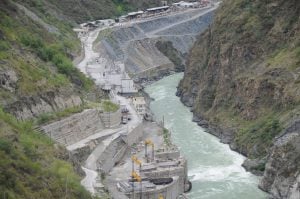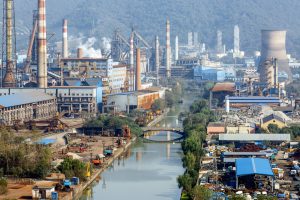The 2004 Indian Ocean tsunami, which buffeted the east coast of India and caused extensive damage to Nagapattinam in Tamil Nadu, left the neighbouring area of Pichavaram, covered in a dense mangrove forest, relatively unharmed. It was one of the landmark events that brought attention to the fact that mangroves act as a bio-shield during natural disasters and aid in adaptation to climate change.
“The tsunami was a wake-up call,” A. Saleem Khan of the Centre for Climate Change and Adaptation Research (CCCAR) in Anna University told indiaclimatedialogue.net. “Nagapattinam, one of the most affected areas, was a few kilometres away from Pichavaram. However, Pichavaram was not heavily affected. Many scientists concluded that these mangroves were a bio-shield to the ecosystem during a coastal disaster like tsunami.”
Pichavaram, the vast expanse of mangrove forests near Chidambaram in Cuddalore district of Tamil Nadu, is located between two estuaries, Vellar estuary in the north and Coleroon estuary in the south. Pichavaram mangroves have been under the threat of rising sea levels (SLR) through sediment erosion, inundation stress and increased salinity in the land areas. These problems will be exacerbated for mangroves that are subjected to coastal squeeze — where migration of these mangroves towards land is restricted by topography or human developments.
Coastal managers, adaptation planners, and policymakers face major challenges to frame suitable coastal adaptation strategies to SLR without reliable, scientific information. Adaptation is considered one of the most appropriate response strategies to address the challenges of SLR at a local level, particularly to conserve major coastal resources.
Need for local data
Due to lack of climate data in the coastal areas, there is not enough understanding of the impact of the changing climate on coastal ecosystems. This is making it difficult to frame climate-based adaptation strategies and policies locally.
Such comprehensive information is rarely available, and seldom lies in the hands of decision makers responsible for the management of the coastal zone. Though there is an understanding of SLR trends, there is uncertainty around its rate and timing. Coastal managers, adaptation planners and policymakers may need scientific information on local sea rise levels such as how much the level will rise and when it is predicted to rise.
However, adaptation measures can offset anticipated mangrove losses and improve resistance and resilience to climate change. Coastal planning, specifically, can be adapted to facilitate mangrove migration with rising sea levels.
A first step towards planning adaptation policies of SLR would be the projection at the local level of different time scales and different scenarios, as devised by the Intergovernmental Panel on Climate Change (IPCC). When future projections are modelled, it could create a crucial input in devising adaptation planning and implementation.

“The science behind this is mean sea level, which is an average of high and low tides. It is a benchmark from IPCC. This may differ from Chennai to Kanyakumari,” Khan told indiaclimatedialogue.net. “For analysing the trend of sea level, we need a minimum of 30 years data. Only then is it called climate information.”
The climate variables are collected and put in a repository. The global data is then projected. Khan says, “Since we need local and regional information, we downscale the global data to local area information through the grid method, using climate modelling.”
Projections on Pichavaram mangroves
The vulnerability of coastal areas to inundation of the Vellar-Coleroon estuarine region of the Tamil Nadu coastline was calculated on the projected SLR scenarios of 0.5 m and 1 m. According to Khan’s paper, Predicted Impact of the Sea-Level Rise at Vellar-Coleroon Estuarine Region of Tamil Nadu Coast in India: Mainstreaming Adaptation as a Coastal Zone Management, out of the total study area of 6,541 hectare (ha) , about 1,570 ha will be inundated to 0.5 m SLR, and at 1 m SLR, about 2,407 ha will be inundated. Dense mangrove area of about 265 ha and 373 ha will be under severe threat of inundation to 0.5 m and 1 m SLR.
Three major coastal natural resources – agriculture, mangroves and aquaculture farms – and the dependent communities are at a high risk of inundation due to rising sea level, the study confirmed.
Khan says, “The coastal areas are undulated. The mangroves, which are on low elevation, will submerge. The data indicates which pockets will submerge. The depths of those areas were marked into highly vulnerable, medium vulnerable and low vulnerable.”
He adds, “One third of the land may go under water, and we have given these predictions for 2050 and 2100 under a moderate or balanced scenario as defined by IPCC. This is assuming that everything goes in the same speed.” If there is change in population or industrial development, these numbers could go higher or lower.
Adaptation and policymaking
Khan, in his research paper, Climate Change Induced Sea Level Projections for the Pichavaram Mangrove Region of the Tamilnadu Coast, India: A Way Forward for Framing Time-Based Adaptation Strategies, looks at how this information can help coastal managers and adaptation planners to frame location-specific and time-based mangrove adaptation strategies to SLR.
The paper suggests that long-term strategic adaptation plans for the full range of possible SLR need to be widely developed. However, the constraints on approaches to adaptation due to broader policy and development goals should be carefully considered.
The recommendation on adaptation strategies from Khan’s study was included in the SLR chapter of the State Action Plan on Climate Change of Tamil Nadu. “We have a number of policies on coastal areas, and we need to have a mainstreaming approach to existing policies,” Khan told indiaclimatedialogue.net. “This falls in line, and works in parallel with the development plan of Tamil Nadu.”
To protect the mangroves from SLR, Khan recommends landward migration. This concept emphasises increasing mangroves on the land rather than the seaward side. This is one of adaptation strategies that have been widely used in Tamil Nadu.
“We need to increase the thickness of the mangroves towards the land side,” Khan said. “This activity is being done by the forest department and MS Swaminathan Research Foundation (MSSRF) for restoration of Pichavaram mangroves, much in tune with the government of India’s effort to protect them.”







![man collecting firewood in Rohingya [image by: Mokammel Shuvo]](https://dialogue.earth/content/uploads/2018/03/Roh1-300x200.jpg)
